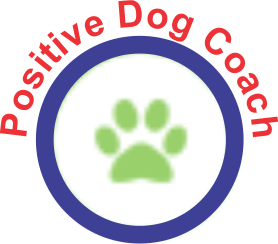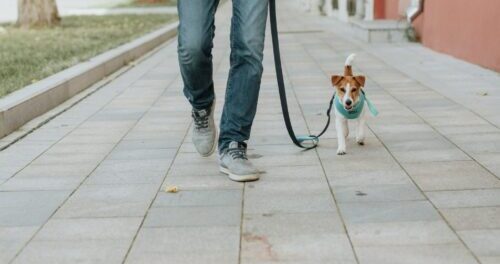This tool is useful for us as we coach Rylee into adulthood. By using goal setting, we can set a pathway to success for her as she is learning skills that will make her the good dog that she wants to be. An example is when we are working on her loose leash walking. We have been give tools by reputable dog trainers, now we need to set up how she is going to get to the end point. Again, I am not a dog trainer at all. I am an experienced and educated coach who is able to use some of the coaching mental training skills in working with our fur baby.
If we use this skill, we can break it down and even use visualization in our planning. The goal is that we want her to be able to walk with us in our neighborhood without pulling ahead of us or lunging at other dogs, squirrels or other distractions. With this goal there are steps that we are taking. During our training, she is receiving treats while we are using markers to let her know she is doing the right thing. Here is a break down of the skill into sections.
- She walks with us as we use treats to help her focus on us.
- She walks with us using treats and is able to move in different directions. In our puppy class we used cones to go around.
- She walks with us through distractions. Starting from further away and then while closer.
- She is able to loos leash walk with us in different situations. This might be when we encounter another dog for example.
We have a tendency to be impatient when working with Rylee. We want everything done quickly. The things is that each dog is different and will grasp onto things differently. We are still working with her on loose leash walking in all situations, and might be for a long time. What we need to do is to make sure we are using the tools that were taught to us through various sources and stay consistent. If we let it go sometimes and have her walk with us other times, she is not going to get it because she will be rehearsing the way we don’t want her to do it. It will also take much longer than it needs to for her to have success.
Goal Setting Considerations
In coaching, we talk about SMART goals. Some of the sport concepts to not apply here in goal setting. I have modified them to better suit our situation. There are considerations that we need to take into account to create the best success for Rylee. First we need to realize that there is a good chance that she does not automatically have the skill if we are teaching it to her. We have had her since she was 10 weeks old. We can use goal setting as we help her to master her newly learned skills. Here are some criteria or steps that we want to use for our training for her.
Simple Goal Setting:
By making the goals simple and setting up a simple environment in relation to her current skill level, she is much more likely to have success. By walking around the house with her leash, it is easy. She knows the environment. We have learned some great ways to break down the skills through the Kikopup You tube videos She then has an obstacle to see which makes it easy for her to pivot in a specific direction.
Measurable:
How do I determine if she has achieved the step that we are working towards. For us, we talk to the certified dog trainer that we work with to find out what the markers are that determine success at each stage of the skill. For us it is good to get that feedback because we know what we want her to know but the progressions are better set by the real professionals.
Achievable:
In our goal setting with Rylee, we need to make the steps achievable. This would refer to the environment and the expectations that I am putting on her. Am I asking Rylee to be able to loose leash walk past a dog before she can do it without any distractions. When she was first learning this skill, we actually would walk her around in the house on the leash. This was way more likely to set her up for success than throwing her into a situation she was not ready for yet. It was achievable.
Reasons:
What situations are these skills going to be most useful in. With loose leash walking, we want to be able to take Rylee for a walk, and not have her lunging at squirrels, other dogs or people if we walk past them. We also want to save our shoulders from trying to contain her if she is pulling. I am separating the reason we want her to learn the skill from what the skill is. This helps us to stay focused on why we are spending so much time teaching Rylee how to walk “nicely” with us.
Time Sensitivity:
Not all goal setting will have times attached. In fact, I have never really thought by a certain date I would like a certain skill mastered. The time sensitivity for us is more about prioritizing skills. There are some skills that we want Rylee to learn sooner than others. For example, we want her to be able to refrain from barking at our guests when she wants attention. This is more of a pressing issue than her being able pass a squirrel without even noticing. There might also be variables in the different stages of skills. We are doing well with Rylee for loose leash walking in our neighborhood. She is not great yet at being able to walk by dogs and squirrels without interest but we can manage as we are working with other skills. The no pulling was the most important part of the skill for safety reasons. We will continue working on the rest as we work on others.
One of the top priority skills for her was the ability to be left alone. For this reason we spent a lot of our focus on enabling her to do that. And through progression and patience, we are now able to successfully leave her for 4 hours in her “condo” we call it.
Some Factors Effecting Goal Setting
Age:
When Rylee was a young puppy, our expectations needed to be lower because of her developmental stage. In our goal setting, we needed to first make sure she felt safe in her new home, and was able to understand what we were asking her to do. Simple was definitely important then. Now she is getting older and has a foundation of skills to draw on, she is able to handle more complex skills that we are working with.
Some characteristics that we wanted to work on were also more prevalent as she got older. When she was really young, her arousal level and testing her environment were not an issue. What a good puppy we would say when she went to greet people that we knew or met on the street. As she has gotten older, her arousal level is more of an issue so we are spending more time coaching her with it.
Breed:
What we know is that some breeds are smarter than others. It does not of course mean that some dogs are not able to learn some skills. It just means that when we are doing our goal setting, we need to consider that some breeds learn quicker than others.
Rewards:
Our little Rylee is very food focused. This makes our training much easier because she wants the food so she will do what we are asking her to do. I have read that food focused dogs can be the easiest to train. If she was not food focused, we would have had to find another way to reward her.
Previous History:
Rylee is a rescue dog that came from an anxious situation. Her mother was stressed and anxious. This means that she would have received some of that predisposition to anxiety through her mothers hormones. We also do not know what her first weeks were like as she was rescued with her mother and 2 other siblings. Some dogs come from very good situations. Many pure breads do because their environment is safe and contains all of the new puppy tools that they need. There also pure breads that come from puppy farms and questionable situations. All of this is going to have an impact on goal setting because it can determine the rate of succession.

